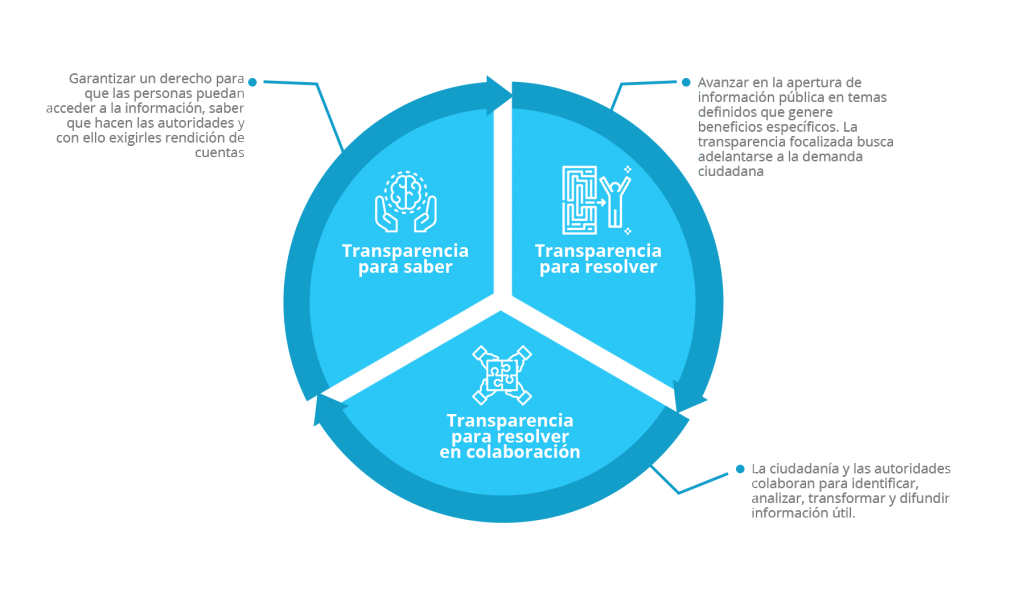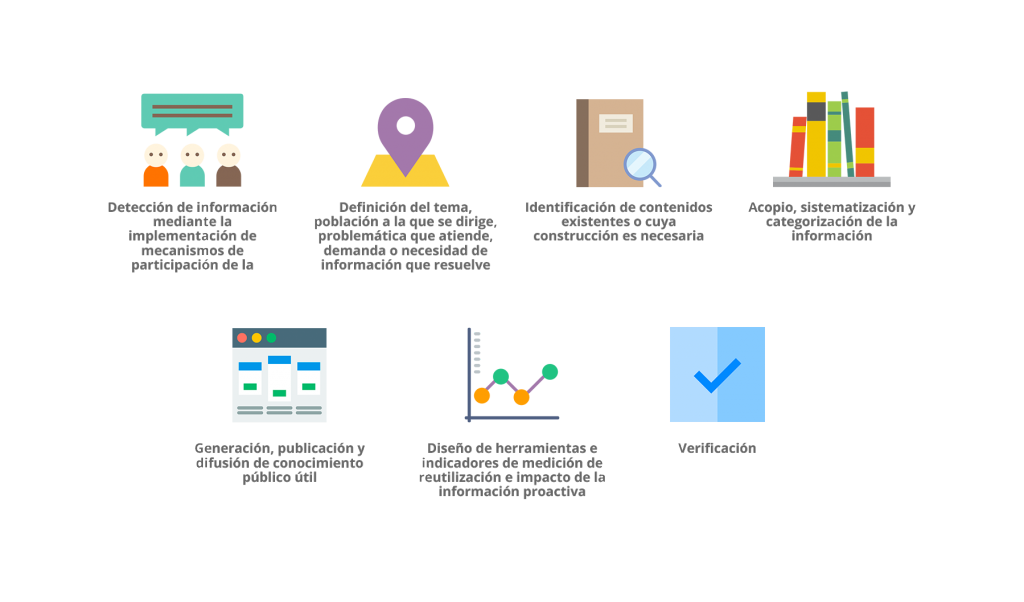
1. What is transparency?
The Transparency is a quality and an obligation of an entity regulated by the General Act of Transparency and Access to Public Information (General Act) to put at people’s disposal the information about the activities such entity performs and the use of the public resources.
2. How has transparency in Mexico evolved?
1977
Article 6 of the Constitution is amended with the addition of the phrase: “The right to information shall be guaranteed by the State”.
2002
The first Federal Act of Transparency and Access to Public Government Information is enacted.
2003
The first Institute of Public Information Access is created with exclusive powers over the federal sphere.
2007
Article 6 of the Constitution is amended, providing a minimal information basis to guarantee the right to access to information in Mexico.
2011
Mexico, together with other eight countries, founded the Open Government Partnership.
2014
IFAI becomes an Autonomous Constitutional Body: National Institute for Transparency, Access to Information and Personal Data Protection (INAI).
2015
INAI extends its scope to all government powers and levels and heads the National Transparency System (SNT)
2016
The Guidelines to determine the dialogues and publication of public interest information, as well as to issue and assess the proactive transparency policies, issued by the National Transparency System, are published in the Official Gazette of the Federation.
2017
Institutional efforts and in the framework of the SNT.
The Open Government Guide is issued in collaboration with SFP.
2018
The 2018 edition of the Open Government Guide is issued in collaboration with the SFP.
3. Products of Transparency

4. What is Proactive Transparency?
Proactive transparency is a set of activities promoting the identification, generation, publication, and diffusion of information, additional to the information determined as mandatory by the General Act, allowing the generation of useful public knowledge with a clear purpose focused on the needs of determined and determinable sectors of the society. 1
5. What is Proactive Transparency for?
Proactive transparency is useful for:
- Reducing the asymmetric information.
- Promoting horizontal relationships among social groups and between such social groups and the authorities.
- Improving access to government procedures and services.
- Optimizing the decision making of authorities and citizens.
- Spurring effective accountability mechanisms.
6. Guidelines to determine the catalogs and publication of public interest information, as well as to issue and assess proactive transparency policies.
The Guidelines to determine the catalogs and publication of public interest information, as well as to issue and assess proactive transparency policies were issued by the National Transparency System (SNT), 2. Their goal is to set the guiding principles for regulated entities to publish public interest information in a proactive manner. In deciding what information shall be published in a proactive manner, the identification proceedings shall be set, considering the following objectives 3:
- Detecting information that reduces information asymmetries means that the understanding and egalitarian access to information generated by the regulated entities must be easy, considering the characteristics of the target population, in order to increase the potential use of such information.
- Detecting information that improves the access to government procedures and services reduces administrative loads for citizens, helps regulated entities to provide their services, and increases the quality and coverage thereof.
- Detecting information that optimizes the decision making of the authorities and/or citizens, improves the understanding of the rights and/or tools to exercise such rights, it also allows or facilitates informed development of activities to the citizens.
- Detecting information that elicits accountability favoring the legitimacy of the regulated entity activities by means of useful information that limits acts of corruption, promotes the examination by citizens, and allows to detect and penalize irregularities in the public administration.
The information identified above will produce useful knowledge to meet the needs of the target population. The generation of proactive information shall include the following steps 4:

7. Proactive Transparency at Federal Context
Considering the agreements made between the Institute and the Minister of Public Administration (SFP), derived from the publication of the “Agreement to issue the General Provisions on the subjects of Archives and Open Government regulating the Federal Public Administration and its Single Exhibit” (General Provisions), the General Head Office of Open Government and Transparency (DGGAT) hold different meetings with the Unit of Open Government and International Cooperation Policies (UPAGCI) of SFP with the purposes of unifying perspectives and points of view regarding open government and proactive transparency to consolidate a standardized tool. From this collaboration, the second edition of the Government Guide was developed in order to comply with the General Provisions.
1 Agreement of the National Council of the National Transparency System, Access to the Public Information and Personal Data Protection, through which the Guidelines to determine the catalogs and publication of the public interest information are approved.
2 Agreement published on April 15, 2016 in the Official Gazette of the Federation, consult it in: http://www.dof.gob.mx/DOFmobile/nota_detalle_popup.php?codigo=5433279.
Modification agreement, consult it in: http://www.dof.gob.mx/nota_detalle.php?codigo=5513940&fecha=21/02/2018
3 Exhibit 1 of the Guidelines to determine the catalogs and publication of public interest information; as well as to issue and assess proactive transparency policies.
4 Idem

01800.835.43.24

Office Hours: Monday-Thursday, 9:00-18:00 and Friday 09:00-15:00.

Insurgentes Sur No. 3211 Col. Insurgentes Cuicuilco, Delegación Coyoacán, C.P. 04530
Our Newsletter is the national Open Government Guide.
It is quarterly updated.
Del responsable de tratar sus datos personales
El Instituto Nacional de Transparencia, Acceso a la Información y Protección de Datos Personales (INAI o Instituto), los cuales serán protegidos conforme a lo dispuesto en la Ley General de Protección de Datos Personales en Posesión de Sujetos Obligados, y demás normatividad que resulte aplicable.
Finalidades
Los datos personales que recabaremos los utilizaremos para las siguientes finalidades:
- Enviar periódicamente un boletín con información seleccionada por el INAI para promover el derecho a la información.
- Integrar un registro de correos electrónicos para enviar invitaciones y/o eventos asociados a las materias de Gobierno Abierto, Transparencia Proactiva, Rendición de Cuentas, Participación Ciudadana, Datos Abiertos, Desarrollo Sostenible, Gobierno Electrónico e Innovación gubernamental o Cívica.
Para esta última finalidad requeriremos de su consentimiento el cual podrá manifestar al momento de registrar su correo electrónico.
Usted podrá consultar el aviso de privacidad integral en el siguiente link web: http://inicio.inai.org.mx/SitePages/Avisos-de-Privacidad.aspx
Fecha de elaboración del aviso de privacidad: 14 de septiembre de 2018.
This is a Website of the National Institute for Transparency, Access to Information and Personal Data Protection, which management is in charge of the General Head Office of Open Government and Transparency. The published information and the document collection are of open access under the terms of the following license:

This work is under the Creative Commons Attribution-Noncommercial-ShareAlike l 4.0 International License.


